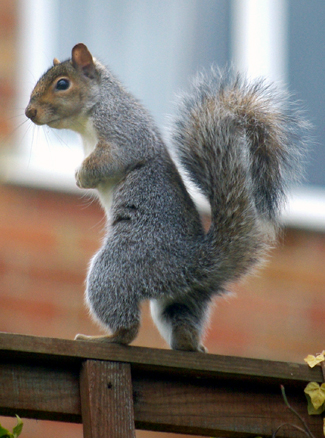Preparing Your Home For Protection Against Squirrels
By Chris Williams on March 20, 2015.
 John Maher: Hi, I’m John Maher, and today I’m here with Scott Winsper of Colonial Pest Control. Scott is a wildlife technician, and today we’re talking about preparing your home for protection against squirrels. Welcome, Scott.
John Maher: Hi, I’m John Maher, and today I’m here with Scott Winsper of Colonial Pest Control. Scott is a wildlife technician, and today we’re talking about preparing your home for protection against squirrels. Welcome, Scott.
Scott Winsper: Hi John, how’re you doing?
Prevent Squirrels from Entering Your Home
John: Good. Scott, what’s the best thing I can do to prevent squirrels from entering my home?
Scott: Well, there’s not very much that you can do to keep squirrels from chewing their way into your home. Gray squirrels are chewers. They can chew through wood. I’ve seen them chew through aluminum soffit edges. There’s not very much you’re going to keep squirrels from getting into your house. They want to get in, they’re going to get in.
John: You could look around your house at the places where things — wires or plumbing, and things like that go into your home, and look for obvious places where there’s holes and they’re able to get in, and try to seal those up. Even if you seal them up, they can still chew their way through.
Scott: Well, if you have gray squirrels, the best thing to do to try to prevent them is cut all of your tree limbs away from your house line. If gray squirrels are going to get into your house, there’s two things they’re going to use to get into your home. They’re going to use tree limbs to get into your house, or they’re going to use your power line that runs from the pole to your house.
Usually that’s where the entry point — they’ll go up the power lines, and they’ll run across, then they’ll get on to the corner of the house. Now, there’s not very prevention to do that. You can’t put anything on your power lines to keep a squirrel from getting onto your home.
John: If I have an oak tree right next to my house and they’re up in the oak tree because they’re getting the acorns, I could cut down the oak tree, I suppose. A lot of people aren’t going to want to cut down a tree just to get rid of squirrels, but you can’t cut down your power lines.
Scott: That’s correct John, you can’t take care of the power lines. That’s usually the biggest issue, especially when you have a congested area where suburban areas are. You got a lot of houses close next to each other, you got a lot of trees close next to each other, and all the power lines.
It’s like a highway. They can run back and forward to any house they want. If a squirrel wants to get in your house, and you got a power line that’s running to the corner of your house, they’re going to get into your house if they want to.
Are there products for squirrel prevention?
John: Should I use any products on my house for prevention or deterrent from squirrels?
Scott: What I recommend is heavy gauge sheet metal. Heavy gauge sheet metal will help you do a little bit deterrent. You see a hole — they chew the hole, patch it with heavy gauge sheet metal or galvanized steel. You have to use something that they’re not going to chew through.
John: Maybe at that point where the wires are coming in from the street to my house, put a plate of metal there.
Scott: That’s correct John. Something right there that’s going to prevent from chewing and getting in there. That’s what I recommend. Some kind of heavy gauge sheet metal, steel screen — any areas like your gable vents. Your gable vent is a good entry point for squirrels when they get in.
We recommend screening your gable vents. What happens is when the squirrel runs your roofline, and they want to get into the gable vent, there’s this piece of steel screen there. It still ventilates your attic, but keeps the gray squirrels out.
John: If I have a pet, is using a squirrel deterrent product safe? Is it OK to use some sort of poison on squirrels?
Scott: We don’t recommend using poison. First of all, it’s illegal to poison squirrels in the state of Massachusetts, so we won’t use poison with squirrels. We trap and remove squirrels humanely. We’ll set traps on the roofline where they’re coming in, just like where the power lines come into your house.
We’ll set traps on the roofline right where they’re coming in, their travel routes; that’s where we’re going to set the traps. So usually when we put traps, it’s not usually where a pet’s going to be. It’s going to be up on the roof, or in your attic area.
John: So no issues there.
Scott: No.
John: That’s great information Scott, thanks very much for speaking with me.
Scott: Thank you, John.
John: For more information, you can visit the Colonial Pest Control website at colonialpest.com, or call 1‑800‑525‑8084. That’s 1‑800‑525‑8084.
Photo credit: Ian D Nolan / Foter / CC BY-SA
Stay up-to-date with Colonial Pest’s email newsletter!